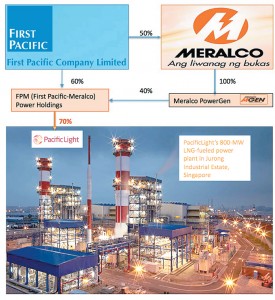Meralco itself is controlled by the Indonesian magnate, since as a First Pacific annual report puts it, Salim’s “intermediate holding companies, subsidiaries, and affiliates” total 50 percent shares in the firm, making him the biggest and controlling stockholder since 2011. (The San Miguel group is a minority with 27 percent of the shares, while the oligarch clan of the Lopezes, which controlled Meralco for decades, before and after martial law, owns only 4 percent now.)
GMR Energy was paid $530 million, while the First Pacific-Meralco joint venture spent another $49 million to complete the power project. As a result of the sale, GMR Energy made $242 million in its three-year investment.
The First Pacific-Meralco firm would also assume the huge $545 million the Indian GMR Energy borrowed from a consortium of banks to finance the power complex’s over $1 billion cost.
The Jurong power company was renamed last April PacificLight Power, while its retail arm was named PacificLight Energy.
GMR Energy was a company of the Mumbai-based infrastructure conglomerate GMR, acronym for its founder and controlling stockholder G.M. Rao, one of India’s billionaires. First Pacific-Meralco’s purchase of his power project in Singapore for $660 million was a boon for the Indian conglomerate which last year had cash-flow problems. After its buying binge in the Philippines in the last five years, Salim’s conglomerate has been moving into India, mainly in construction projects.
According to a recent Meralco investors’ quarterly briefing, the company will spend P9 billion ($215 million) for its stake in the Singapore power firm.
Meralco’s exposure is the biggest single foreign investment by a domestic company in recent years, significant enough that the firm’s outward remittances explain the huge outflow of dollars towards the end of last year.
It is not clear whether Meralco’s P9 billion exposure was sourced from borrowings or from its huge profits in its operations in the Philippines.
What irony. When the announcement was made of his firm’s exit out of the Singapore power industry, the Indian conglomerate’s chairman G.M. Rao said: “The cash flows (from the sale) will help GMR Energy to focus on our domestic energy business and accelerate ongoing (power) projects with a 5,790 MW capacity.”
In our case, Meralco is spending P9 billion to own a power plant in Singapore, when the Philippines is facing a power crisis because there are not enough investments to finance the building of electricity generation plants here.
The Jurong plant could be very profitable for Meralco. But something must be terribly wrong here when our biggest utility firm, which controls 60 percent of the electricity market, chooses to invest billions of pesos outside the country, which has been capital-deficient.
Could this be the biggest flaw of a system in which private investors—driven of course by capitalism’s prime directive of making money— own a firm which has a monopoly over the sale of an essential commodity, electricity?
Or could this be just the flaw of having a foreigner—a citizen of Indonesia, which is essentially our competitor in the global market—controlling our biggest electricity company? (Details on this in the coming columns.)
No one certainly can blame Mr. Salim if he steers Meralco —with its overflowing war chest filled by profits from Filipino consumers suffering atrocious electricity bills and by borrowings from the local capital market—to profitable ventures abroad while the Philippines goes under. That is a real possibility with our country having electricity costs that are the fifth highest in the world, and five times that of Indonesia.
www.trigger.ph and www. rigobertotiglao.com
FB: Rigoberto D. Tiglao



